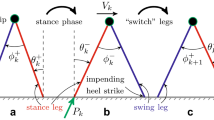Abstract
Udwadia–Kalaba equation is a simple, aesthetic and thought-provoking description of the world at a very fundamental level. It is about the way systems of bodies move. We creatively apply the Udwadia–Kalaba approach to study falling cat’s movements. The cat is modeled as a constrained discrete dynamical system. In an alternative way, Udwadia–Kalaba formulation is used for analysis of the falling cat’s dynamics. With this novel approach, we can easily obtain the dynamical model and get the explicit analytic form of the general equations of motion of the falling cat. The surprise phenomenon (that a cat when dropped at rest with its feet pointing up can always manage to right itself and land safely on its feet) is observed through numerical simulation based on the constructed dynamical model. Unmatched ease, clarity and elegance of the Udwadia–Kalaba formulation for solving the falling cat problem (constrained discrete dynamical system or multibody system) are presented.













Similar content being viewed by others
Explore related subjects
Discover the latest articles and news from researchers in related subjects, suggested using machine learning.References
Appell, P.: Sur une Forme Generale des Equations de la Dynamique. Comptes rendus de l’Academie des sciences 129, 459–460 (1899)
Batterman, R.W.: Falling cats, parallel parking, and polarized light. Stud. Hist. Philos. Mod. Phys. 129, 1–40 (2003)
Baumgarte, J.: Stabilization of constraints and integrals of motion in dynamical systems. Comput. Methods Appl. Mech. Eng. 1, 1–16 (1972)
Bjerhammer, A.: Rectangular reciprocal matrices with special reference to geodetic calculations. Bull. Geod. 52, 188–220 (1951)
Dirac, P.A.M.: Lectures in Quantum Mechanics. Yeshiva University, New York (1964)
Gauss, C.F.: Uber ein neues allgemeines Grundgsetz der Mechanik. Journal of die reine und angewandte Mathematik 4, 232–235 (1829)
Ge, X., Chen, L.: Optimal control of nonholonomic motion planning for a free-falling cat. Appl. Math. Mech. 7, 601–607 (2007). doi:10.1007/s10483-007-0505-z
Guyou, E.: Note Sur Les Approximations Numeriques. Kessinger Publishing, Montana (1891)
Gibbs, J.W.: On the fundamental formulae of dynamics. Am. J. Math. 2, 49–64 (1879)
Kane, T.R.: Dynamics of nonholonomic systems. J. Appl. Mech. 28(4), 574–578 (1961)
Kane, T.R., Scher, M.P.: A dynamical explanation of the falling cat phenomenon. Int. J. Solids Struct. 5, 663–670 (1969). doi:10.1016/0020-7683(69)90086-9
Kane, T.R.: Dynamics, 3rd edn. Stanford University, Stanford, CA (1978)
Kane, T.R., Levinson, D.A.: Multibody dynamics. J. Appl. Mech. 50, 1071–1078 (1983)
Kane, T.R., Levinson, D.A.: Dynamics: Theory and Application. McGraw-Hill, New York (1985)
Lagrange, J.L.: Mechanique Analytique. Mme ve Courcier, Paris (1787)
Liu, Y.Z.: On the turning motion of a free-falling cat. Acta Mech. Sin. 4, 388–393 (1982) (In Chinese)
Loitsyansky, A.I.: Theoretical Mechanics. Saint Petersburger, Moscow (1953)
Marey, M.: Méchanique Animale. La Nature 119, 596–597 (1894)
McDonald, D.A.: How does a cat fall on its feet? New Sci. 7, 1647–1649 (1960)
Montgomery, R.: Gauge theory of the falling cat. Am. Math. Soc. 1, 193–218 (1993)
Moore, E.H.: On the reciprocal of the general algebraic matrix. Bull. Am. Math. Soc. 26, 294–395 (1920)
Pars, L.A.: A Treatise on Analytical Dynamics. Ox Bow Press, Connecticut (1965)
Penrose, R.: A generalized inverse of matrices. Proc. Cambr. Philos. Soc. 51, 404–413 (1955)
Udwadia, F.E., Kalaba, R.E.: A new perspective on constrained motion. Proc. R. Soc. 439, 407–410 (1992). doi:10.1098/rspa.1992.0158
Udwadia, F.E., Kalaba, R.E.: Analytical Dynamics: A New Approach. Cambridge University Press, Cambridge (1996)
Udwadia, F.E., Kalaba, R.E.: Explicit equations of motion for mechanical systems with non-ideal constraints. J. Appl. Mech. 68, 462–467 (2001). doi:10.1115/1.1364492
Udwadia, F.E., Kalaba, R.E.: On constrained motion. Appl. Math. Comput. 164, 313–320 (2005). doi:10.1016/j.amc.2004.06.039
Udwadia, F.E., Phohomsiri, P.: Explicit equations of motion for constrained mechanical systems with singular mass matrices and applications to multi-body dynamics. Proc. R. Soc. 462, 2097–2117 (2006). doi:10.11098/rspa.2006.1662
Zhao, H., Zhen, S.C., Chen, Y.H.: Dynamic modeling and simulation of multibody systems using the Udwadia–Kalaba theory. Chin. J. Mech. Eng. 26(5), 839–850 (2013)
Zhen, S.C., Zhao, H., Huang, K., Chen, Y.H.: On Kepler’s law: application of the Udwadia–Kalaba theory. Sci. Sin. Phys. Mech. Astron. 44(1), 24–31 (2014) (in Chinese)
Zhong, F.: A two-rigid-body model of the free-falling cat. Acta Mech. Sin. 17, 1 (1985)
Acknowledgments
Here, we show thanks and appreciations sincerely to Professor Jie Tian of Hefei University of Technology (China) for his instructions and help during the process of research. The research is supported by the National High-tech Research and Development Program of China (863 Program: 2012AA112201).
Author information
Authors and Affiliations
Corresponding author
Rights and permissions
About this article
Cite this article
Zhen, S., Huang, K., Zhao, H. et al. Why can a free-falling cat always manage to land safely on its feet?. Nonlinear Dyn 79, 2237–2250 (2015). https://doi.org/10.1007/s11071-014-1741-2
Received:
Accepted:
Published:
Issue Date:
DOI: https://doi.org/10.1007/s11071-014-1741-2




